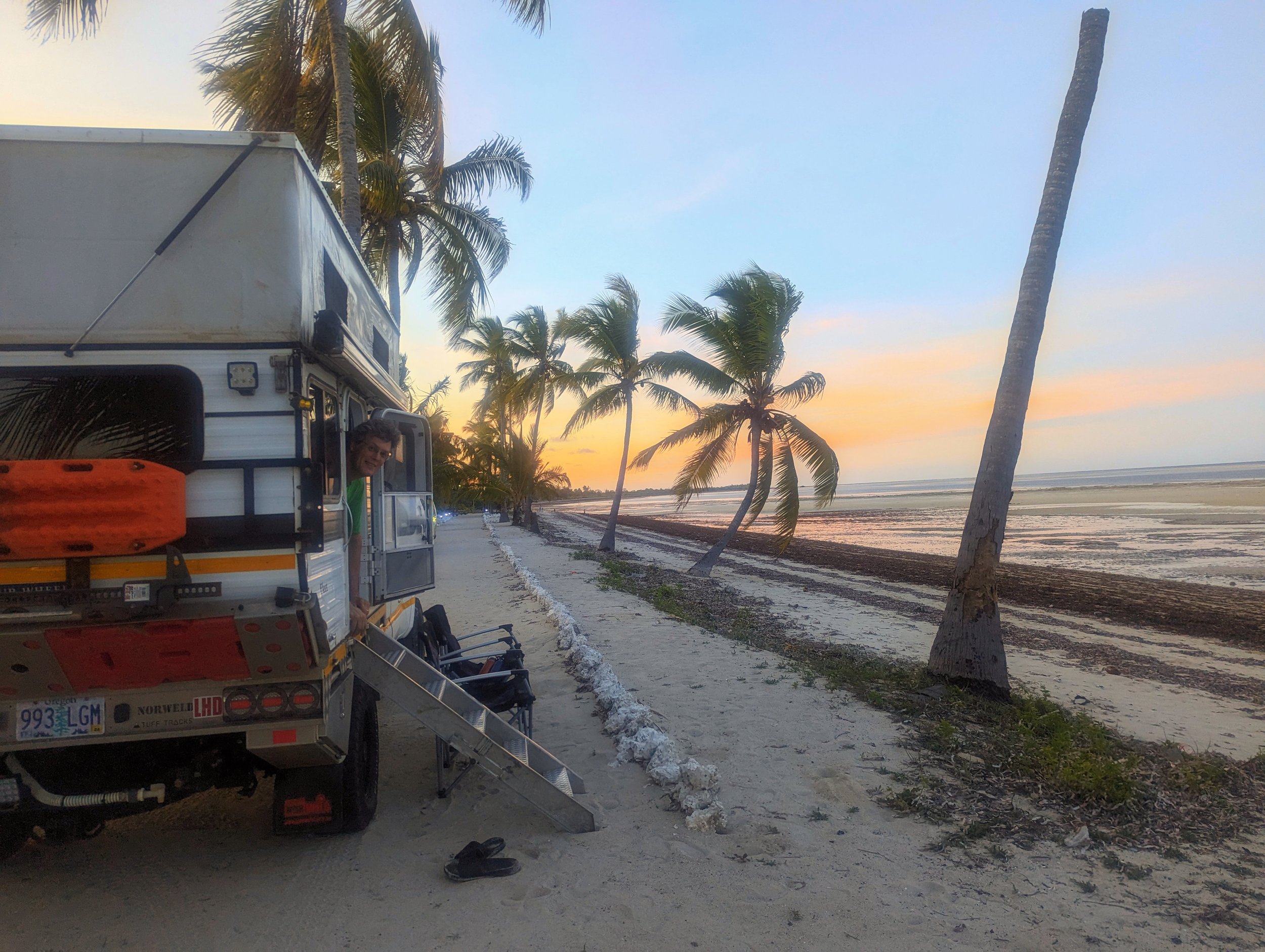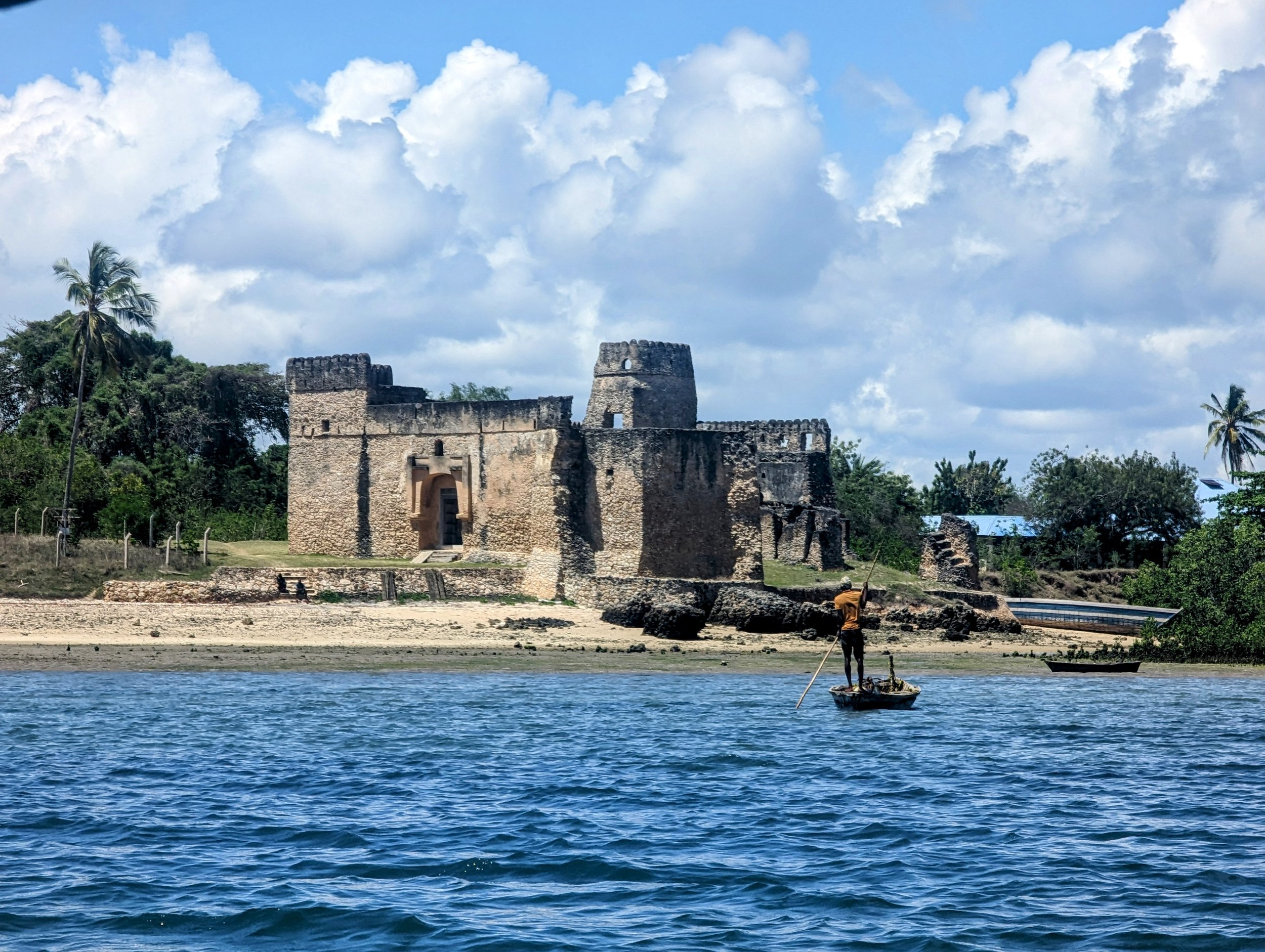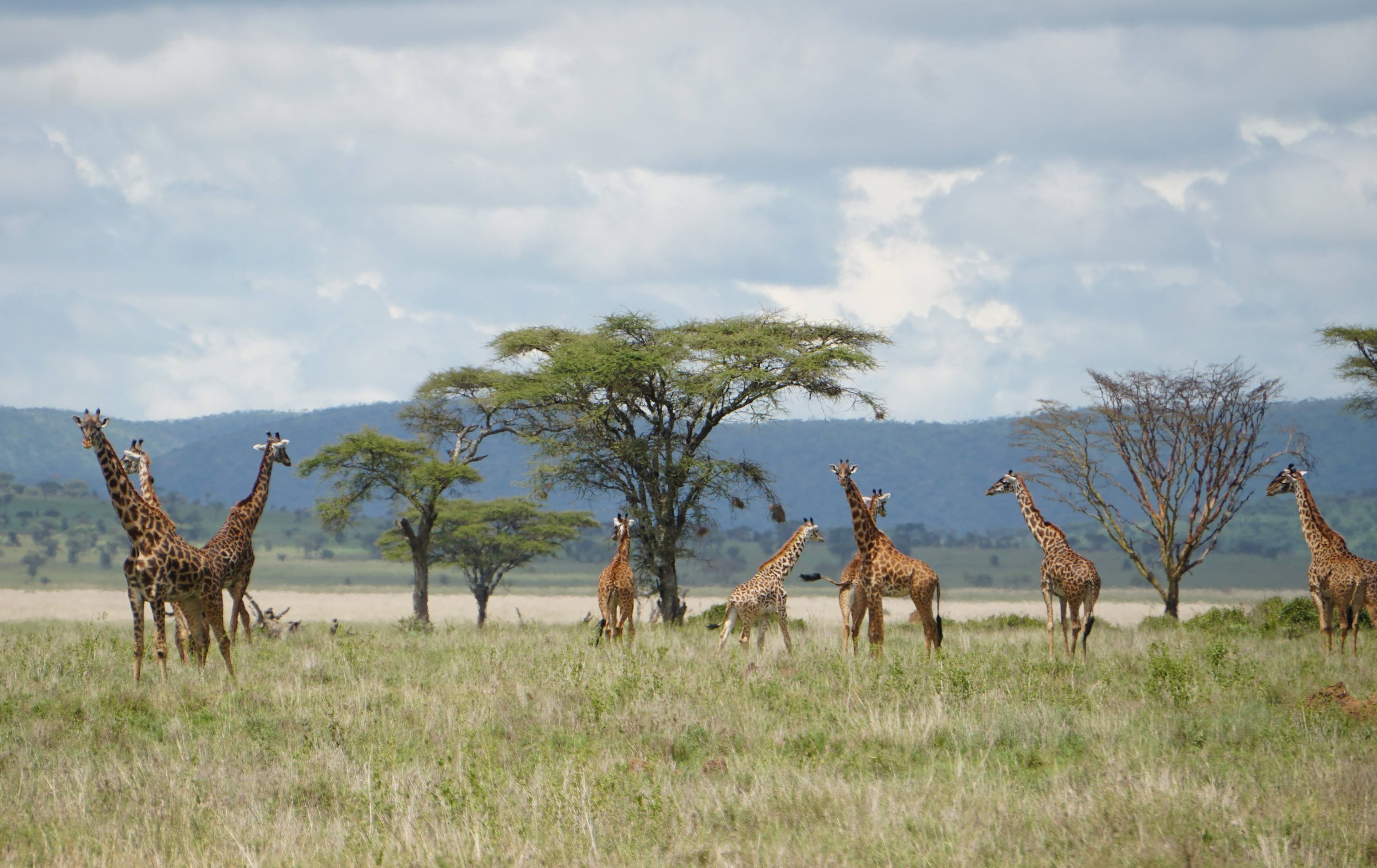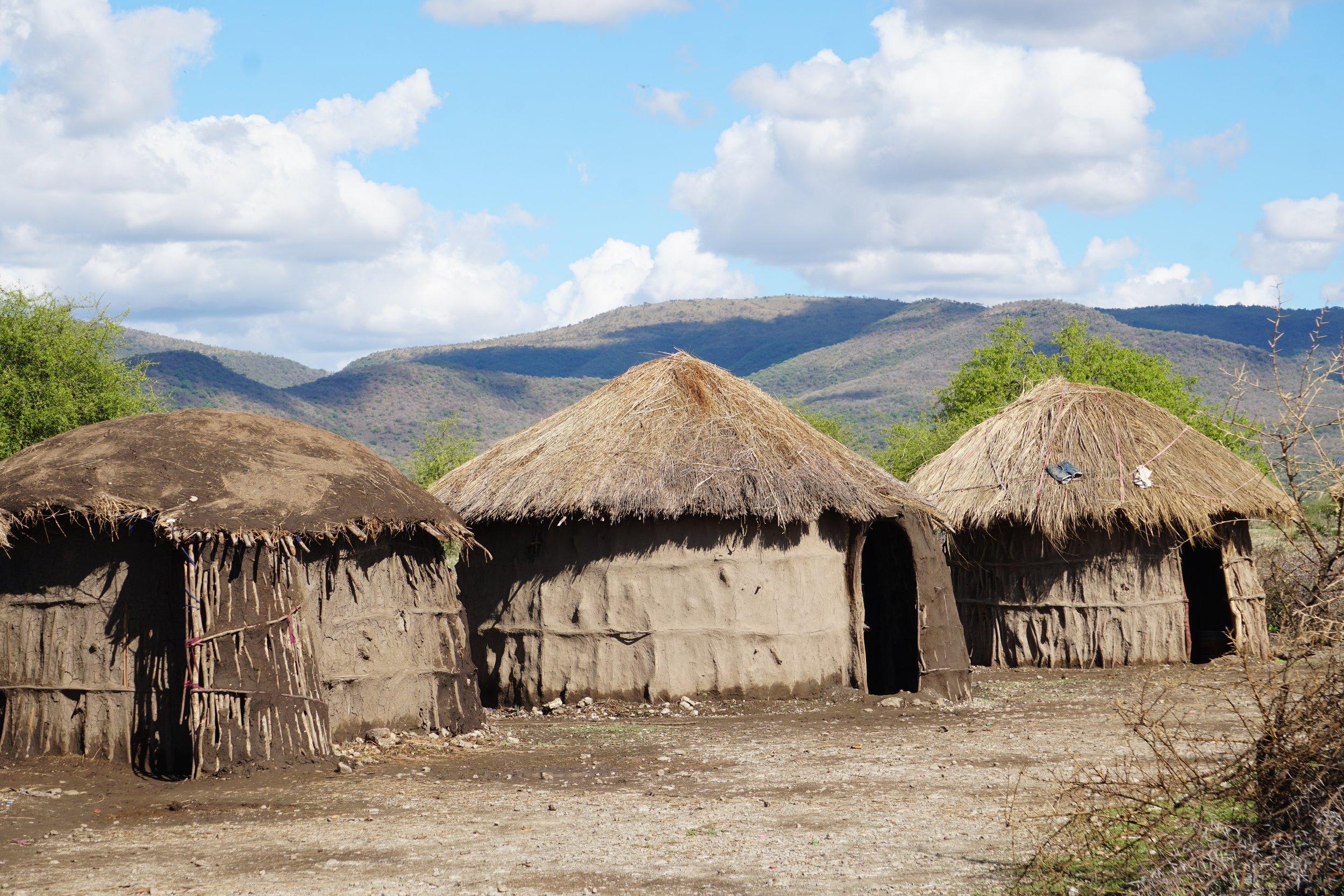Tanzania
Mount Kilimanjaro popping out of the clouds.
We think Tanzania is scenically the most beautiful African country we have been to. It has everything - the gorgeous sandy beaches of Zanzibar, the magic of Ngorongoro Crater, the majestic Mount Kilimanjaro, the endless vistas of the Serengeti with wildlife galore, and the bustling modern city of Dar es Salaam which manages to be both contemporary and capture ancient traditions and culture.
Our one month route through Tanzania
Welcome dance at Masai village
Then, of course there are the people. The kind smiles, the gentle teaching of Swahili words, sharing of culture and knowledge, and the rightful pride in being a peaceful nation. Tanzanians we spoke with delighted in pointing out that in their country people of diverse religions, economic backgrounds and cultures live in harmony side by side. We wish it were so everywhere in the world. The only downside to traveling in Tanzania is that the extraordinary experiences and places come at some of the highest cost we have seen in Africa.
Our 27th African border crossing! Soon there will be a beautiful one stop facility, now still a bit of a work in progress.
We entered Tanzania filled with anticipation, ready once again for some African animal encounters and excited to visit the island of Zanzibar. As is often the case with border crossings, our optimistic guess of 90 mins was wrong by half so we were late and a little at a loss for where to spend the night. We ended up in our least favorite scenario, a budget guest house parking lot, but it was safe and the owner kind and welcoming.
Overlanding is not always camping at scenic wilderness sites, delays at the border meant it was getting dark so we pulled into this guesthouse where the owner kindly made room for us.
More bananas than bike! Not the craziest load we have seen in Africa, but it speaks to peoples’ balancing skills.
Throughout Africa there are a few private overland camps that rise to the top in reputation because of the location, facilities, overlanding owners or uniqueness. (Zebra Bar in Senegal, The Mushroom Farm in Malawi, The Farmhouse in Matobo in Zimbabwe, Kakuako Lodge in Angola, Jungle Junction in Kenya come to mind.) The Old Kisolanza Farmhouse in Iringa is one of those. Right along the main route from the border to Dar es Salaam, The Farmhouse provides lovely separated camping spots, spotless ablutions with warm showers, a historic farm building which serves as the restaurant and bar, excellent wifi and fresh bread baked daily.
Relaxing in the The Old Kisolanza Farmhouse lounge, historic mud built building
Camping with private palapa at The Farmhouse
And then as a bonus, two guys came by our campsite offering hair cuts and pedicures (we must have looked like we needed it, which we did).
Andy’s new haircut thanks to Jackson
Dawn’s happy feet - first campground pedicure!
To top it off we splurged ($15 per person) and enjoyed a three course meal with everything from the farm. Delicious.
From the Farmhouse it was an easy drive to visit the Isimila Stone Pillars, an intriguing place with stone age relics and a valley of crazy rock towers.
Walking the ridge at Isimila
Beautiful old traditional home
Feeling the day
Isimila Natural Stone Pillars
The most colorful lizard we have ever seen
So much to explore. Andy always climbing something.
We were careful not to hit a giraffe
Because Tanzania is expensive, we were very selective about which national parks we went to. Similar to Zambia, we camped at the edge of a few to get the sense of the area. For our truck, fees to bring it into a park are at least $200, sometimes more. And then there are the person fees, the conservancy fees and the national park camping fees. The least inexpensive parks would cost us close to $400 for the night. But basic campgrounds outside of the national parks averaged $10 a person.
We made our way slowly towards Dar es Salaam, enjoying some beautiful campgrounds along the way.
It was definitely possible to hit wildlife . . . transit road through Mikumi National Park
Only campers at Camp Bastian at the edge of Mikumi National Park.
Camping with a mountainous backdrop - easy to do in Tanzania
Then - the big city! Our first skyscrapers in a long time, it was a bit unnerving to be speeding along a multi lane highway with a city skyline ahead.
It was time to take care of some basic housekeeping so we found an Airbnb with a washer/dryer and got to work.
It took us a little bit to find the washer dryer in the apartment - it was out on the balcony, which actually worked well.
As we have said many times, cities are not usually our happy place but we surprisingly liked Dar es Salaam. It was very walkable (it actually has sidewalks!), an appealing coastline and a variety of neighborhoods to explore. We also had one major errand to take care of. After a couple of years of international travel and many visas, our passports were full. We had booked an appointment at the US Embassy in Dar es Salaam to get new ones. The whole process was amazingly easy, we filled out a form online in advance, made an appointment a month out and learned that we would receive our passports two weeks after our in person appointment. Time to explore the city.
Local fish market, one of the largest in Africa
Every size fish imaginable
And, we had a truck issue that we had been saving for a big city. The aftermath of our experience with the inept off road shop in Cape Town continued. Andy had discovered that when they rebuilt the worn out bushings in the upper control arms, they actually installed them upside down and on the wrong side. So a visit to a (also highly recommended but much more professional) shop in Dar es Salaam got them re-installed the right way round.
For Dawn, no city exploration is complete with a visit to local artists so we made sure to go to the Tinga Tinga Arts Cooperative Society to learn more about this unique Tanzanian art style.
Dawn with artist Shibumi displaying the painting we could not live without
Tinga Tinga Arts Cooperative, Dar es Salaam, art style named after Tanzanian artist Edward Tingatinga known for his colorful surrealistic paintings.
Morning walk along the coast, yes we are already hot and sweaty
Made it to our appointment for new passports
With two weeks to fill before we could pick up our passports at the embassy, we headed south for some beach time combined with a visit to a Unesco ruins site.
The sun goes down at Kilwa Beach Lodge, one of our favorite spots
Using Kilwa beach as our base, we arranged for a day trip out to the Kilwa Kisiwani ruins, remnants of a 13th-16th century East African trading center. The trip involved hiring a guide and a boat which our campground hosts were kind to set up for us.
First view of Kilwa Kisiwani ruins from our boat
Admiring one of the early forts
Incredible to wander through history, just us and our guide.
Ancient mosque
Another ancient mosque
Touring one of the sultan’s palaces
And among the ruins on the island, a traditional village with people living in beautifully designed stone homes with thatch rooves
The sultan’s swimming pool
Brilliant sunny day at Kilwa Beach lodge. Camping does not get any better than this. (Well, when you flushed the toilet the pipe providing the water would pop off the wall and flood the room, but other than that . . )
Walking the beach at low tide
As we continued our journey our days of brilliant sunshine slowly faded away as we entered the realities of wet season. We got used to the sight of stormy skies and spontaneous thunder and lightening accompanied by torrential downpours.
Feeling like we had well explored the area, we headed north to camp outside Nyerere National Park along the Selous River.
Storm clouds approaching, becoming a familiar sight
Private river camping site at Selous Mapumziko on the Selous River
Our Masai guide leading the way for us to drive in to Selous River Camp
Continuing to watch the budget, we enjoyed camping on the outskirts of the national park then headed back to the Dar es Salaam to catch the ferry out to Zanzibar.
Roads starting to show the effects of the rain
We opted not to take the truck to Zanzibar so found our way to Kipepeo Beach Village outside Dar es Salaam which provided both beach side camping and $5 a day storage for vehicles.
View from the camper one morning at Kipepeo Beach. We were admiring beach life and the gorgeous fabrics worn by the Masai people.
Beach walk with storm clouds at Kipepeo Beach
Zanzibar is one of those place names which evoked mystery, history and a sense of adventure for us. We booked our ferry, hopped in a taxi from the campground and set off.
Arriving at the ferry terminal was one of our more hectic experiences in a while, reminiscent of a border where lots of people want to “help” for a fee. We braved the scrum, declining assistance and found our way to the waiting room, eventually boarding the right ferry.
Gorgeous little girl on the ferry. We are always impressed by the beauty of how people dress in Africa, even children.
Without the truck, were back to Airbnb and hotels we could get for free on our credit card (we use a Chase Sapphire visa for everything, earning rewards and then book all of our hotels on points). We opted to spend a few nights in Stone Town so that we could explore the old city then switch to a beach resort.
Stone Town was a wonderful place to wander. It reminded us of a smaller, newer Fez in Morocco. Similar to Morocco, the old doors were incredible (and Andy’s favorite).
Door to one of the few (stealth) alcohol stores in Stone Town. We arrived at the location Google sent us to a little perplexed. When we approached the guard across the street with the question of where the store was, he smiled and banged on the door. They opened up and there was a cavern filled with beer, wine and liquor. We got our supplies and went on our way.
One of Andy’s favorite doors
Waterfront promenade near ferry terminal on Zanzibar
Stone Town, Zanzibar fish market, we are endlessly fascinated by fish markets in Africa, so much variety. The smell not our favorite though.
Fruits much more pleasantly aromatic
So many bananas
Old fort on Zanzibar waterfront
Wandering the old streets of Stone Town
Watching life go by at the central market while we sit at an MTN umbrella to add more data to our sim cards. Throughout Tanzania we saw traditionally dressed Masai (wrapped in colorful plaid blankets, machete at the hip, recycled tire sandals) selling intricately beaded sandals.
Market life
Community fishing boat
Each enjoying our own breakfasts, Dawn omelet and latte, Andy chocolate cake, passion fruit tart and juice
Running through rain storms in Stone Town, underground channels overflowing, wading through rivers of water in the alleyways, Dawn learning not to think about what might be in the water
Three days in Stone Town and we felt like we knew our neighbors in the small street, smiling greetings every day and sharing stories. Time to leave and head to the beach, weather not a deterrent.
Our taxi driver taking us out to our resort, pre-walking the road to ensure we wouldn’t get stuck.
Now, resort time! Our first real resort in three years. We were like kids in a candy shop. Robes!!! Counter space!! Bedside tables, a sitting area, private plunge pool . . .
Our old REI daypacks seem out of place
Classic white sand beaches of Zanzibar
Enjoying daily walks and non-driving days
Beaches of Zanzibar
Then back to the mainland and what has become our “real” life. We got on the road to Arusha. We debated back and forth about whether or not to invest in visiting the Serengeti and Ngorongoro. It would cost us $200 for the truck, $70 each and $30-$50 each for camping in the Serengeti. Total over $400 a day. For Ngorongoro, there is no camping in the crater but camping nearby was similar rates and the vehicle fee was $300, plus you have to hire a licensed guide and pay all the conservancy fees (we guessed a total of about $700 for a day visit in our own truck). We had great memories of fantastic wildlife encounters at Etosha, Chobe, Kruger, and Mana Pools and wondered if we really needed more. In the end we decided to see what it would cost to go with a tour.
Dawn went on safaribookings.com and requested three quotes for a four day budget tour of the two parks. The lowest cost was $700 each to join a group of four in a safari vehicle, four days, three nights all inclusive. We would even be visiting an addional park, Tarangire. We went for it. Best decision! Our professional guide, Bakari knew were all the big wild cats hung out and bumping along with him in his safari vehicle on the corrugated access roads to the Serengeti did not create the same mental stress of imagining what the shaking was doing to our own truck. We even had a personal chef along who cooked us three hot meals a day. It felt luxurious to us. Except for the return to sleeping in a ground tent which was a bit of a let down after our camper, but all in a good cause.
Drive to Arusha
Camping with a peekaboo view of Mount Kilimanjaro. We spent the night at Tulivu Retreat, a lovely garden campsite with the best outside kitchen and most beautiful showers that we have seen in a campsite.
Then we left our truck at the hostel owned by our safari tour operator (Nelson of Focus in Africa) and jumped in a safari jeep - feeling like real tourists for the first time in a while. Our roundtrip itinerary out of Arusha was an afternoon in Tarangire National Park, two days in Serengeti National Park, and a final day in Ngorongoro Crater Conservation Area.
Pile of giant bones at Tarangire National Park entrance gate
Our joyful tour group (we were the oldest by at least 3 decadees)
First view from above of the mystical Ngorongoro Crater
We stopped by the view point of the crater on our way to Serengeti National Park. Masai for “endless plain” the Serengeti became one of our favorite national parks in Africa. The views were stunning and the wildlife incredibly plentiful. Instead of a few wildebeests, we would see 100’s at a time, huge packs of hyenas, towers of giraffes, lion prides eating carcasses or sleeping off a night of hunting. It was all so impressive and quintessentially African. Previously we had only really seen a cheetah at a distance through binoculars, now we had the thrill of seeing a mom with cubs walking through the plain.
Lions in the Serengeti
Bush walk near the Serengeti
Safari lunch in the bush
Representing Japan, France and the USA
Evening leopard spotting
More hippos than we have ever seen in one place
Animals on the plain for as far as the eye can see
We find the yellow eyes of the lions to be mesmerizing
Biggest tower of giraffes we have ever seen (Dawn loves that animal group word and has been waiting to use it, seems really appropriate)
Cheetah with her cubs
Our safari tents - camped in the Serengeti
On our last day when we drove down into the crater we weren’t sure what else we could see, but our guide Bakari brought even more action.
Lionesses feasting while a jackal waits standing by hopefully
View of the crater from inside
Hyena in Ngorongoro Crater
Hippo eyeing us warily
Throughout our time in the this area of Tanzania we would see the Masai people in the bush, shepherding goats and cows, carrying wood, living traditional lives in beautiful round homes surrounded by bomas of thorny branches. We were curious to learn more about their culture so arranged to visit a village that welcomed tourists. It was way too little time to develop any real understanding, but still a fascinating experience to walk and talk with the chief’s son and visit his home.
Young Masai men dressed traditionally
Traditional dance
Shoes creatively fashioned out of old tires
Andy and the chief’s son
Beautiful homes, narrow tunneled entrances for safety
Then we were back on the road again. Despite being full of wild animal experiences, there was one more we were looking forward to. We made our way to Jane Goodall’s research center, now Gombe National Park, in the hopes of a chimpanzee encounter.
Wild camping along the way
We took an early morning boat ride (2 hours) arrived at the park and set off with our excellent guide, Paolo to find the chimps. Having been accustomed to people in the area (Jane Goodall and her researchers), although wild, the chimpanzees in Gombe National Park do not typically run away from humans. But, sadly they did run from us. Despite 5 hours of (very) steep trekking we never caught up to them so left unfulfilled. We understood, it is nature, not a zoo, but still disappointing (also fee for the day trip was $300pp).
Camped at Jakobsen Beach in Kigoma
Andy still seeking interesting insects to hold
Rainforest hike in Gombe National Park. Lots of trees, no chimps.
Another wild camping spot along the way
And that ended our time in Tanzania. We left satiated with animal encounters (despite missing the chimps) and with an appreciation for the varied geography and lovely people of the country. It is a country we would return to someday. Thank you for reading!
















































































































